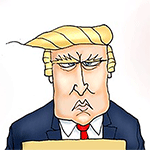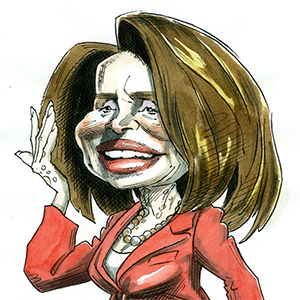From the Left
/Politics
When Elon Speaks ...
Something very scary happened in Washington this week. The world's richest man flexed his political muscle.
And the House collapsed.
All in a day.
Republicans and Democrats had negotiated for months about a spending bill to avoid a government shutdown -- complicated negotiations to keep the government funded through mid-March including $110...Read more
ABC News Caves to the Bully
Pitiful.
That's the best I can say about ABC's decision to settle the defamation suit that Donald Trump brought against ABC News because star anchor George Stephanopoulos said he had been held liable for "rape."
Trump's claim: he was not held civilly liable for "rape," but for "sexual assault."
In fact, the judge had already rejected Trump'...Read more
A Broken System
What does it mean that an alleged murderer has become a folk hero, that literally millions of people in this country have taken his side -- in social media, at least, if not as potential jurors -- in a case of cold-blooded murder? What does it mean that the McDonald's employees who reported him have had to resort to police protection to deal ...Read more
The MAGA Attack on Joni Ernst
The first woman combat veteran to serve in the Senate, and a sexual assault survivor, Iowa Sen. Joni Ernst understandably had serious questions about the nomination of Pete Hegseth to be Secretary of Defense.
Initially, she said he would "have his work cut out for him" to be confirmed and told Fox News that she was not yet a "yes" on his bid,...Read more
'Woke Crap' or Pete Hegseth's Mission
In an interview taped Wednesday for Megyn Kelly's radio show, Secretary of Defense nominee Pete Hegseth said Trump told him he wanted a "warfighter" who would clean out the "woke crap."
What "woke crap"?
The "woke crap" that allows some 15,000 qualified transgender service members -- the best estimate I could find -- to risk their lives for ...Read more
Hunter Biden's Pardon
Of course he pardoned his son. Joe Biden had already lost one son, as well as his wife and his daughter. He lost his ability to seek reelection, and then Democrats lost the election, for which he was roundly blamed. His son was facing prison time, a disaster for former addicts; as former President Bill Clinton put it, there was "reason to ...Read more
And So It Ends
On Monday, Special Counsel Jack Smith filed motions to dismiss the two pending criminal cases against Donald Trump, the D.C. case centered on his actions to subvert the result of the 2020 election and the Florida case about classified documents.
The legal system failed.
Just how it failed is a matter of some debate. "If Donald J. Trump had ...Read more
The Transgender War
She has yet to even be sworn in. But the hateful Republican women in the House of Representatives have already declared war on the first openly transgender woman to be elected to Congress, Sarah McBride. She is my new hero.
Rep. Nancy Mace of South Carolina, who The New York Times describes as "one of the more attention-seeking members of the...Read more
He's Trolling Us
What to make of Donald Trump's nominations of the Fox News team to the Trump Cabinet? Attorney General Gaetz? Can this be serious? An expert on wrestling to take down the Department of Education? An opponent of public health to run Health and Human Services? What kind of game is this? Is he really just trolling us to see how far outside the ...Read more
The Matt Gaetz Test
Are you shocked? Matt Gaetz as attorney general. A man with virtually no experience as anything other than an election denier, a Jan. 6 troublemaker who called the rioters "patriotic Americans," a man who was within days of a withering report from the House Ethics Committee on everything from underage sex to misuse of campaign funds, this is the...Read more
Sez Us
Sez Us is a new social media platform founded by long-time Democratic strategist Joe Trippi. It's an alternative to "X" and Truth Social, which are of course now wholly controlled subsidiaries of Donald Trump Inc. Trippi, who recently appeared on my podcast, "No Holding Back," is as smart as any Democrat I know and has been around the block ...Read more
The Blame Game
And now it begins. America has elected a very flawed candidate. An aging, raging bully. Not the first choice of many Republican leaders. Not an acceptable alternative. Not a moderate by any standard. Not presidential by any definition.
So, who's to blame? I was on Black radio last night, and Tavis Smiley asked me if it was white women who ...Read more
What Do You Hear?
Will angry young men who are attracted by Donald Trump's sexist machismo and utter lack of a filter actually turn out to vote? Will latent sexism rear its ugly head, as it did in 2016, leading Trump to perform better than his poll numbers predict?
Will young women, who have every reason to be angry about losing their rights, and every reason ...Read more
The Bully and the Billionaire
It was a front-page story in The Washington Post back in October 2019. Amazon was in line to receive a $10 billion contract from the Department of Defense for cloud computing (the Joint Enterprise Defense Infrastructure, or JEDI, contract) when, at the last minute, the contract was awarded to Microsoft. Then-President Donald Trump has been ...Read more
The Week That Was
It was a week that would doom most candidates for high office. It began with Donald Trump going on a riff about Arnold Palmer's penis size, that the late golfer's daughter understandably found offensive. Did his supporters? Apparently not.
It got worse from there. If you don't mind a president who is focused on penis size, what about one who ...Read more
Trump Justice
An ABC story, which should have gotten more attention than it did, reports that a proposed appointment roster entitled "Transition Planning: Legal Principals" lists Judge Aileen Cannon, the federal district judge who threw out the classified documents case against Donald Trump, as a candidate for attorney general if Trump gets elected. Cannon,...Read more
The Endless Campaign
"Cat Eats Fox" was Matt Drudge's headline after Kamala Harris' much touted "interview" with Fox News anchor Bret Baier. It wasn't really an interview. He whined about her coming in 15 minutes late for a pretaped interview and then barely let her answer a question before interrupting her, talking over her and generally just playing to his Fox ...Read more
Beyond Weird
It started as a joyful campaign. When President Joe Biden dropped out, Kamala Harris, the president's pick and soon after the pick of every prominent Democrat, quickly secured the nomination. No one put themselves up against her. It was a relief and a joyful coronation. Her vice presidential nominee was the salt of the earth. Coach Tim. The ...Read more
'The Message' and The Interview
On Sept. 30, bestselling author Ta-Nehisi Coates appeared on the "CBS Mornings" show to promote his book "The Message," which is a one-sided critique of Israel as an apartheid state. The book compares Israel to the "Jim Crow South" and calls it out as the "one place on the planet -- under American patronage -- that resembled the world that my ...Read more
What Matters
Bob Woodward's new book, "War," has what we have come to expect as the usual number of blockbuster revelations, proving once again his skill at loosening the lips of those close to power. My favorite is the story that in the midst of drastic shortages at home and abroad, Donald Trump was sending Covid tests off to his authoritarian buddy in ...Read more






















